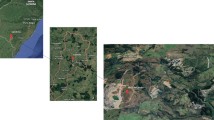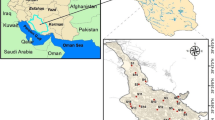Abstract
This study investigates the concentrations of PM10-bound PAHs and their seasonal variations in three cities of Ahvaz, Abadan, and Asaluyeh in Iran. The mean concentrations of PM10 in two warm and cold seasons in Ahvaz were higher and in Abadan and Assaluyeh were lower than the national standard of Iran and the guidelines of the World Health Organization. The Σ16 PAHs concentration in ambient air PM10 during the cold season in Ahvaz, Abadan and Asaluyeh was 244.6, 633, and 909 ng m− 3, respectively, and during the warm season in Ahvaz, Abadan, and Asaluyeh was 242.1, 1570 and 251 ng m− 3, respectively. The high molecular weight PAHs were the most predominant components. The most abundant PAHs species were Pyr, Chr, B [ghi] P, and Flt. The results showed that the total PAHs concentration in the cold and warm seasons was dependent on industrial activities, particularly the neighboring petrochemical units of the city, vehicular exhausts, traffic and use of oil, gas, and coal in energy production. The total cancer risk values as a result of exposure to PAHs in ambient air PM10 in all three cities for children and adults and in both cold and warm seasons were between 1 × 10− 6 and 1 × 10− 4, and this indicates a potential carcinogenic risk. Therefore, considering the various sources of air pollutants and its role on people’s health, decision makers should adopt appropriate policies on air quality to reduce the ambient air PAHs and to mitigate human exposure.




Similar content being viewed by others
References
WHO. Health aspects of air pollution with particulate matter, ozone and nitrogen dioxide: report on a WHO working group, Bonn, Germany, 13–15 January 2003. Geneva: World Health Organization; 2003.
Masiol M, Hofer A, Squizzato S, Piazza R, Rampazzo G, Pavoni B. Carcinogenic and mutagenic risk associated to airborne particle-phase polycyclic aromatic hydrocarbons: a source apportionment. Atmos Environ. 2012;60:375–82.
Zhang Y, Tao S. Global atmospheric emission inventory of polycyclic aromatic hydrocarbons (PAHs) for 2004. Atmos Environ. 2009;43(4):812–9. https://doi.org/10.1016/j.atmosenv.2008.10.050.
Ravindra K, Wauters E, Van Grieken R. Variation in particulate PAHs levels and their relation with the transboundary movement of the air masses. Sci Total Environ. 2008;396(2–3):100–10.
WHO. Obesity: preventing and managing the global epidemic. Geneva: World Health Organization; 2000.
Humans IWGotEoCRt. Some non-heterocyclic polycyclic aromatic hydrocarbons and some related exposures. IARC Monogr Eval Carcinog Risks Hum. 2010;92:1.
Kumar B, Verma VK, Kumar S, Sharma CS. Probabilistic health risk assessment of polycyclic aromatic hydrocarbons and polychlorinated biphenyls in urban soils from a tropical city of India. J Environ Sci Health A. 2013;48(10):1253–63.
Wang W, Huang M-j, Kang Y, Wang H-s, Leung AOW, Cheung KC, et al. Polycyclic aromatic hydrocarbons (PAHs) in urban surface dust of Guangzhou, China: Status, sources and human health risk assessment. Sci Total Environ. 2011;409(21):4519–27. https://doi.org/10.1016/j.scitotenv.2011.07.030.
Hailwood M, King D, Leoz-Garziandia E, Maynard R, Menichini E, Moorcroft S, et al. Ambient Air Pollution by Polycyclic Aromatic Hydrocarbons (PAH), Position Paper. Publication officielle du groupe de travail sur les HAP pour l’Union …; 1995.
Gehle K. Agency for Toxic Substances and Disease Registry (ATSDR) case studies in environmental medicine toxicity of polycyclic aromatic hydrocarbons (PAHs). Atlanta: USA Department of Health and Human Services Agency for Toxic Substances and Disease Registry Division of Toxicology and Environmental Medicine; 2009.
Tuyen LH, Tue NM, Suzuki G, Misaki K, Viet PH, Takahashi S, et al. Aryl hydrocarbon receptor mediated activities in road dust from a metropolitan area, Hanoi—Vietnam: Contribution of polycyclic aromatic hydrocarbons (PAHs) and human risk assessment. Sci Total Environ. 2014;491–2:246 – 54. https://doi.org/10.1016/j.scitotenv.2014.01.086.
Burchiel SW, Luster MI. Signaling by environmental polycyclic aromatic hydrocarbons in human lymphocytes. Clin Immunol. 2001;98(1):2–10.
Hassanvand MS, Naddafi K, Faridi S, Arhami M, Nabizadeh R, Sowlat MH, et al. Indoor/outdoor relationships of PM10, PM2.5, and PM1 mass concentrations and their water-soluble ions in a retirement home and a school dormitory. Atmos Environ. 2014;82:375–82.
Hassanvand MS, Naddafi K, Faridi S, Nabizadeh R, Sowlat MH, Momeniha F, et al. Characterization of PAHs and metals in indoor/outdoor PM10/PM2. 5/PM1 in a retirement home and a school dormitory. Sci Total Environ. 2015;527:100–10.
Samburova V, Zielinska B, Khlystov A. Do 16 polycyclic aromatic hydrocarbons represent PAH air toxicity? Toxics. 2017;5(3):17.
Wang C, Wu S, Zhou S, Shi Y, Song J. Characteristics and source identification of polycyclic aromatic hydrocarbons (PAHs) in urban soils: a review. Pedosphere. 2017;27(1):17–26.
Liu J, Wang Y, Li P-H, Shou Y-P, Li T, Yang M-M, et al. Polycyclic aromatic hydrocarbons (PAHs) at high mountain site in North China: Concentration, source and health risk assessment. Aerosol Air Qual Res. 2017;17:2867–77.
Yang Q, Chen H, Li B. Polycyclic aromatic hydrocarbons (PAHs) in indoor dusts of Guizhou, southwest of China: status, sources and potential human health risk. PLoS One. 2015;10(2):e0118141.
Soltani N, Keshavarzi B, Moore F, Tavakol T, Lahijanzadeh AR, Jaafarzadeh N, et al. Ecological and human health hazards of heavy metals and polycyclic aromatic hydrocarbons (PAHs) in road dust of Isfahan metropolis, Iran. Sci Total Environ. 2015;505:712–23. https://doi.org/10.1016/j.scitotenv.2014.09.097.
EPA U. Exposure Factors Handbook 2011 Edition (Final). Washington, DC: US Environmental Protection Agency, EPA/600/R-09/052F. 2011.
Staff E. Supplemental Guidance for Developing Soil Screening Levels for Superfund Sites, Peer Review Draft. Washington, DC: US Environmental Protection Agency Office of Solid Waste and Emergency Response, OSWER. 2001:9355.4–24.
Ferreira-Baptista L, De Miguel E. Geochemistry and risk assessment of street dust in Luanda, Angola: a tropical urban environment. Atmos Environ. 2005;39(25):4501–12.
Petry T, Schmid P, Schlatter C. The use of toxic equivalency factors in assessing occupational and environmental health risk associated with exposure to airborne mixtures of polycyclic aromatic hydrocarbons (PAHs). Chemosphere. 1996;32(4):639–48.
Pongpiachan S, Tipmanee D, Deelaman W, Muprasit J, Feldens P, Schwarzer K. Risk assessment of the presence of polycyclic aromatic hydrocarbons (PAHs) in coastal areas of Thailand affected by the 2004 tsunami. Mar Pollut Bull. 2013;76(1):370–8. https://doi.org/10.1016/j.marpolbul.2013.07.052.
Shahsavani A, Yarahmadi M, Hadei M, Sowlat MH, Naddafi K. Elemental and carbonaceous characterization of TSP and PM 10 during Middle Eastern dust (MED) storms in Ahvaz, Southwestern Iran. Environ Monit Assess. 2017;189(9):462.
Goudie AS. Desert dust and human health disorders. Environ Int. 2014;63:101–13.
Goudarzi G, Alavi N, Babaei AA, Geravandi S, Idani E, Salmanzadeh S, et al. Investigation of ambient polycyclic aromatic hydrocarbons in a populated middle eastern city. Polycycl Aromat Compd. 2020:1–16.
Callén M, López J, Iturmendi A, Mastral A. Nature and sources of particle associated polycyclic aromatic hydrocarbons (PAH) in the atmospheric environment of an urban area. Environ Pollut. 2013;183:166–74.
Unwin J, Cocker J, Scobbie E, Chambers H. An assessment of occupational exposure to polycyclic aromatic hydrocarbons in the UK. Ann Occup Hyg. 2006;50(4):395–403.
Slezakova K, Castro D, Pereira MC, Morais S, Delerue-Matos C, Alvim-Ferraz MC. Influence of traffic emissions on the carcinogenic polycyclic aromatic hydrocarbons in outdoor breathable particles. J Air Waste Manag Assoc. 2010;60(4):393–401.
Hoseini M, Yunesian M, Nabizadeh R, Yaghmaeian K, Ahmadkhaniha R, Rastkari N, et al. Characterization and risk assessment of polycyclic aromatic hydrocarbons (PAHs) in urban atmospheric Particulate of Tehran, Iran. Environ Sci Pollut Res. 2016;23(2):1820–32.
Stogiannidis E, Laane R. Source characterization of polycyclic aromatic hydrocarbons by using their molecular indices: an overview of possibilities. Reviews of environmental contamination and toxicology. Berlin: Springer; 2015, p. 49–133.
Kaur S, Senthilkumar K, Verma VK, Kumar B, Kumar S, Katnoria JK, et al. Preliminary analysis of polycyclic aromatic hydrocarbons in air particles (PM10) in Amritsar, India: Sources, apportionment, and possible risk implications to humans. Arch Environ Contam Toxicol. 2013;65(3):382–95. https://doi.org/10.1007/s00244-013-9912-6.
Yunker MB, Macdonald RW, Vingarzan R, Mitchell RH, Goyette D, Sylvestre S. PAHs in the Fraser River basin: a critical appraisal of PAH ratios as indicators of PAH source and composition. Org Geochem. 2002;33(4):489–515.
Larsen RK, Baker JE. Source apportionment of polycyclic aromatic hydrocarbons in the urban atmosphere: a comparison of three methods. Environ Sci Technol. 2003;37(9):1873–81.
Douglas GS, Stout SA, Uhler AD, McCarthy KJ, Emsbo-Mattingly SD. Advantages of quantitative chemical fingerprinting in oil spill identification and allocation of mixed hydrocarbon contaminants. Standard Handbook Oil Spill Environmental Forensics. 2nd ed. Amsterdam: Elsevier; 2016. p. 789–847.
Guo H, Lee S, Ho K, Wang X, Zou S. Particle-associated polycyclic aromatic hydrocarbons in urban air of Hong Kong. Atmos Environ. 2003;37(38):5307–17.
Krugly E, Martuzevicius D, Sidaraviciute R, Ciuzas D, Prasauskas T, Kauneliene V, et al. Characterization of particulate and vapor phase polycyclic aromatic hydrocarbons in indoor and outdoor air of primary schools. Atmos Environ. 2014;82:298–306.
Saber D, Mauro D, Sirivedhin T. Environmental forensics investigation in sediments near a former manufactured gas plant site. Environ Forensics. 2006;7(1):65–75.
Wickramasinghe A, Karunaratne D, Sivakanesan R. PM10-bound polycyclic aromatic hydrocarbons: Concentrations, source characterization and estimating their risk in urban, suburban and rural areas in Kandy, Sri Lanka. Atmos Environ. 2011;45(16):2642–50.
Lee B-K, Dong TT. Toxicity and source assignment of polycyclic aromatic hydrocarbons in road dust from urban residential and industrial areas in a typical industrial city in Korea. J Mater Cycles Waste Manage. 2011;13(1):34–42.
Rostami R, Zarei A, Saranjam B, Ghaffari HR, Hazrati S, Poureshg Y, et al. Exposure and risk assessment of PAHs in indoor air of waterpipe cafés in Ardebil, Iran. Build Environ. 2019;155:47–57.
Acknowledgements
We would like to thank the Environmental Technologies Research Center (ETRC), Ahvaz Jundishapur University of Medical Sciences (AJUMS) for the financial support of this grant project (ETRC-9401). The authors would also like to thank the people who are responsible for Abadan Refinery and Pars Special Economic Energy Zone (PSEEZ) for helping us to take samples.
Author information
Authors and Affiliations
Corresponding author
Ethics declarations
Conflict of interest
The authors declare that they have no conflict of interest which might influence the results of the research.
Additional information
Publisher’s note
Springer Nature remains neutral with regard to jurisdictional claims in published maps and institutional affiliations.
Rights and permissions
About this article
Cite this article
Goudarzi, G., Baboli, Z., Moslemnia, M. et al. Assessment of incremental lifetime cancer risks of ambient air PM10-bound PAHs in oil-rich cities of Iran. J Environ Health Sci Engineer 19, 319–330 (2021). https://doi.org/10.1007/s40201-020-00605-6
Received:
Revised:
Accepted:
Published:
Issue Date:
DOI: https://doi.org/10.1007/s40201-020-00605-6




